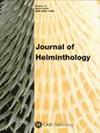Congenital transmission of Schistosoma japonicum in the rabbit
IF 1.3
3区 生物学
Q4 PARASITOLOGY
引用次数: 0
Abstract
Fourteen pregnant rabbits were each infected with 300 cercariae of日本血吸虫在兔子体内的先天性传播
14 只怀孕的兔子各感染了 300 个日本血吸虫carcariae,并分为两组。M 组(n = 8)在妊娠中期(器官发生阶段)感染,L 组(n = 6)在妊娠晚期(器官发生后阶段)感染。母兔和幼兔在感染后 45-60 天被杀死,并进行灌流以获得虫数。此外,还对母兔和幼兔进行了粪便虫卵计数和肝脏组织虫卵计数。所有母兔均受到感染,M 组和 L 组分别有 207.6 ± 20.2 和 220.0 ± 27.5 个成虫。在 M 组和 L 组中,分别有 13.5% 和 46.7% 的幼猫受到感染。14窝幼猫中有12窝至少有一只受到感染。受感染的幼猫体内有一到三只日本鼠成虫。受虫卵对感染的幼猫肝脏因虫卵沉积而出现移位病变。因此,研究结果表明,日本弓形虫可在兔子体内先天传播。兔子胎盘与人类胎盘在解剖学上的相似性可能表明,日本弓形虫感染在人类中存在先天性传播。
本文章由计算机程序翻译,如有差异,请以英文原文为准。
求助全文
约1分钟内获得全文
求助全文
来源期刊

Journal of Helminthology
生物-动物学
CiteScore
2.80
自引率
12.50%
发文量
127
审稿时长
3 months
期刊介绍:
Journal of Helminthology publishes original papers and review articles on all aspects of pure and applied helminthology, particularly those helminth parasites of environmental health, medical or veterinary importance. Research papers on helminths in wildlife hosts, including plant and insect parasites, are also published along with taxonomic papers contributing to the systematics of a group. The journal will be of interest to academics and researchers involved in the fields of human and veterinary parasitology, public health, microbiology, ecology and biochemistry.
 求助内容:
求助内容: 应助结果提醒方式:
应助结果提醒方式:


